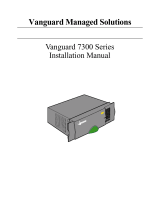Page is loading ...

Bay Networks, Inc., Corporate Headquarters
4401 Great America Parkway, Santa Clara, CA 95054
8 Federal Street, Billerica, MA 01821
Part No. 115066-A Rev. B
Installing a Fast Packet Cache Upgrade
in ASN and SN Platforms
This document describes how to install a Fast Packet Cache module upgrade in a
Bay Networks® Access Stack Node (ASN
™
) or Switch Node
™
(SN
™
). You will need a
Phillips screwdriver (ASN), a flat-tip screwdriver (SN), and a pair of needle-nose pliers to
complete the following steps:
1. Removing the ASN component tray or the SN CPU module
2. Removing the Fast Packet Cache module (optional)
3. Installing the standoffs
4. Installing the Fast Packet Cache module
5. Replacing the ASN component tray or the SN CPU module
Attaching the Antistatic Wrist Strap
You must wear an antistatic wrist strap whenever you remove, install, or handle a module.
To attach the antistatic wrist strap:
1.
Remove the strap, alligator clip, and cable from the package.
2.
Attach (snap) the snap end of the cable to the wrist strap.
3.
Place the strap around your wrist, and adjust the strap to ensure that the metal
buckle inside the strap touches your skin.
4.
Plug the jack at the other end of the cable into the opening on the alligator clip.
5.
Attach the alligator clip to any unpainted metal surface on the ASN component
tray or Switch Node chassis.
Caution:
Electrostatic discharge can damage hardware. Follow the procedure
in this section to protect your equipment from damage.

2
Part No. 115066-A Rev. B
Removing the ASN Component Tray
To remove the ASN component tray:
1.
Turn off the ASN, and detach all cables from the back panel.
2.
Using a Phillips screwdriver, loosen the two captive screws that fasten the tray to
the chassis (Figure 1).
3.
Pull the two captive screws and gently slide the tray out of the chassis.
Make sure to hold the sides and bottom of the tray to support it; try to keep the tray
level as you slide it out.
4.
Place the tray on a sturdy work surface.
You are now ready to replace or install the Fast Packet Cache module. Go to the
appropriate section:
• If you are replacing a Fast Packet Cache module with a new one, you must first
remove the old one. Go to “Removing the Fast Packet Cache Module.”
• If you are
not
replacing an old Fast Packet Cache module, go to “Installing the
Standoffs.”
Caution:
Do not touch any components or modules in the ASN until you have
attached an antistatic wrist strap. Refer to the section “Attaching the Antistatic
Wrist Strap.”
Note:
The net module ports are exposed at the back of the component tray. To
perform maintenance tasks on the ASN components, face the back of the tray.

3
Part No. 115066-A Rev. B
Figure 1. Removing the ASN Component Tray
Captive
thumbscrews
Component tray
ASN0031A
Phillips
screwdriver

4
Part No. 115066-A Rev. B
Removing the Switch Node CPU Module
To remove the SN CPU module:
1.
Turn off the Switch Node.
2.
Disconnect any modem and console cables that are attached to the CPU module.
3.
Remove the flash memory card from the PCMCIA slot by pressing the eject
button to the right of the slot.
4.
Using a flat-tip screwdriver, loosen the captive retaining screws (F
igure 2).
5.
Press the module levers down so that they are parallel to the front of the module.
You will feel the module disconnect from the Switch Node midplane.
6.
Grasp the module by its edges to remove it from the chassis.
7.
Place the module on an antistatic work surface.

5
Part No. 115066-A Rev. B
Figure 2. Removing the Switch Node CPU Module
You are now ready to replace or install the Fast Packet Cache module. Go to the
appropriate section:
• If you are replacing a Fast Packet Cache module with a new one, you must first
remove the old one. Go to “Removing the Fast Packet Cache Module.”
• If you are
not
replacing an old Fast Packet Cache module, go to “Installing the
Standoffs.”
100 BASE-TX
ATM OC-3
10BASE-T
FX0021A
1
2
1
2
4
3
PCMCIA
Reset
Console/ Diagnostics Console/ Modem
CPU 060
Captive
screw
Flash memory card
Module lever
Module lever

6
Part No. 115066-A Rev. B
Removing the Fast Packet Cache Module
To remove the Fast Packet Cache module:
1.
Using needle-nose pliers, pinch the plastic standoffs that hold the Fast Packet
Cache module in place (3 standoffs for the ASN, 4 standoffs for the Switch Node).
Figure 3 shows the location of the Fast Packet Cache module on the ASN.
Figure 3. Locating the Fast Packet Cache Module (ASN)
Figure 4 shows the location of the Fast Packet Cache module on the Switch Node.
ASN0039A
Fast Packet Cache module

7
Part No. 115066-A Rev. B
Figure 4. Locating the Fast Packet Cache Module (SN)
2.
While using the pliers to push down on each standoff, lift up on the module just
enough to release it from the standoff (Figure 5).
Fast Packet
Cache module
FX0024A
Reset
Console/ Diagnostics
Console/ Modem
CPU 060

8
Part No. 115066-A Rev. B
Figure 5. Releasing the Module from the Standoffs
3.
Grasp the sides of the module and pull up to release it from its connector.
4.
Leave the standoffs in place.
Go to “Installing the Fast Packet Cache Module.”
ASN0064A
Standoffs

9
Part No. 115066-A Rev. B
Installing the Standoffs
The Fast Packet Cache module ships with 4 plastic standoffs. If you are installing a Fast
Packet Cache module for the first time in an ASN, you must install 3 standoffs. If you are
installing a Fast Packet Cache module for the first time in a Switch Node, you must install
4 standoffs, as shown in Figure 6.
Figure 6. Installing the Standoffs
To install a standoff on the Fast Packet Cache module:
1.
Position the module with the connector side up (refer to Figure 6).
2.
Push the end of the standoff through the mounting hole.
Installing the Fast Packet Cache Module
To install the Fast Packet Cache module:
1.
Align the module connector with the connector on the ASN base module
(Figure 7), or on the SN CPU module (Figure 8).
• If you are installing the module for the first time, align the standoffs on the
module with the mounting holes on the ASN base module or on the SN CPU.
• If you are replacing the module, align the mounting holes on the module with the
plastic standoffs already on the ASN base module or on the SN CPU.
2.
Press the module securely into place.
FX0026B
Standoffs (3 on ASN)
Fourth standoff on Switch Node

10
Part No. 115066-A Rev. B
Figure 7. Aligning the Fast Packet Cache Module (Initial Installation on ASN)
ASN0066A
Mounting holes
Connector

11
Part No. 115066-A Rev. B
Figure 8. Aligning the Fast Packet Cache Module (Initial Installation on SN)
Replacing the ASN Component Tray
To replace the ASN component tray:
1.
Gently slide the tray into the chassis.
2.
Using a Phillips screwdriver, tighten the two captive screws that fasten the tray to
the chassis (refer to Figure 1).
3.
Reattach the cables to the proper connectors on the back panel.
4.
Turn on the ASN.
4 standoffs
Mounting holes
FX0025A
Reset
Console/ Diagnostics
Console/ Modem
CPU 060
Connector

12
Part No. 115066-A Rev. B
Replacing the Switch Node CPU Module
To replace the SN CPU module:
1.
Make sure the module levers are parallel to the front of the module.
2.
Hold the CPU and align the sides of the module to the guides in the CPU slot
(F
igure 9).
Figure 9. Replacing the CPU Module
3.
Insert the module into the chassis until you feel resistance, then press firmly to
make the connection with the Switch Node midplane.
4.
Firmly push the levers inward (so that they are pointed toward you) to fully
engage the locking mechanism.
5.
Using a flat-tip screwdriver, tighten the two captive retaining screws on the front
of the CPU module.
100 BASE-TX
ATM OC-3
10BASE-T
FX0020A
1
2
1
2
4
3
PCMCIA
Reset
Console/ Diagnostics Console/ Modem
CPU 060
Captive
screw
Guide
Module lever
Module lever

13
Part No. 115066-A Rev. B
6.
Turn on the Switch Node.
7.
Observe the CPU module LEDs to determine whether the module is functioning
properly.
Refer to
Installing and Maintaining the Switch Node Platform
for information about
the LEDs
.

/

